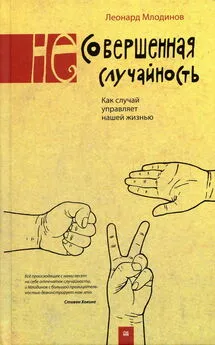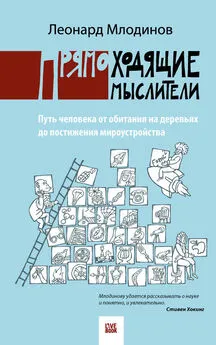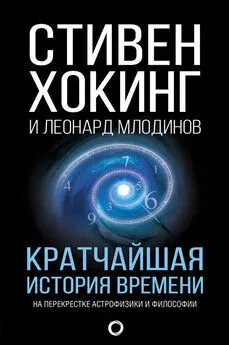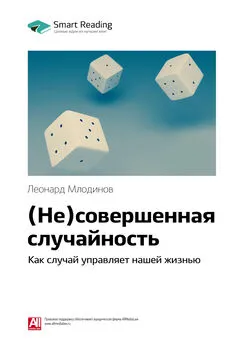Леонард Млодинов - (Нео)сознанное. Как бессознательный ум управляет нашим поведением
- Название:(Нео)сознанное. Как бессознательный ум управляет нашим поведением
- Автор:
- Жанр:
- Издательство:Livebook
- Год:2012
- Город:Москва
- ISBN:978-5-904584-34-4
- Рейтинг:
- Избранное:Добавить в избранное
-
Отзывы:
-
Ваша оценка:
Леонард Млодинов - (Нео)сознанное. Как бессознательный ум управляет нашим поведением краткое содержание
Все наши суждения — от политических предпочтений до оценки качества бытовых услуг — отражают работу нашего ума на двух ярусах: сознательном и неосознанном, скрытом от нашего внимания. Неповторимый стиль Леонарда Млодинова — живой, ясный язык, юмор и способность объяснять сухие научные факты так, чтобы они были понятны самой широкой аудитории — позволяет нам понять, как неосознанное влияет на нашу жизнь, по-новому взглянуть на отношения с друзьями, супругами, пересмотреть представления о себе самих и о мире вокруг.
vk.com/psyfb2
(Нео)сознанное. Как бессознательный ум управляет нашим поведением - читать онлайн бесплатно ознакомительный отрывок
Интервал:
Закладка:
374
B.M. Bass and F.J. Yamarino, «Congruence of self and others’ leadership ratings of naval officers for understanding successful performance», Applied Psychology 40 (1991), pp. 437–454.
375
Scott R. Millis et al., «Assessing physicians’ interpersonal skills: Do patients and physicians see eye-to-eye?», American Journal of Physical Medicine & Rehabilitation 81, no. 12 (December 2002), pp. 946–951; Jocelyn Tracey et al., «The validity of general practitioners’ self assessment of knowledge: Cross sectional study», British Medical Journal 315 (November 29, 1997), pp. 1426–1428.
376
David Dunning et al., «Flawed self-assessment».
377
A.C. Cooper et al., «Entrepreneurs’ perceived chances for success», Journal of Business Venturing 3 (1988), pp. 97-108; L. Larwood and W. Whittaker, «Managerial myopia; Self-serving biases in organizational planning», Journal of Applied Psychology 62 (1977), pp. 194–198.
378
David Dunning et al., «Flawed self-assessment»; David Dunning, Self Insight: Roadblocks and Detours on the Path to Knowing Thyself (New York: Psychology Press, 2005), pp. 6–9.
379
M.L.A Hayward and D.C. Hambrick, «Explaining the premiums paid for large acquisitions: Evidence of CEO hubris», Administrative Science Quarterly 42 (1997), pp. 103–127; U. Malmendier and C. Tate, «Who makes acquisitions? A test of the overconfidence hypothesis», Stanford Research Paper 1798 (Palo Alto; Stanford University, 2003).
380
T. Odean, «Volume, volatility, price, and profit when all traders are above average», Journal of Finance 8 (1998), pp. 1887–1934. Обзор Шиллера см. Robert J. Schiller, Irrational Exuberance (New York: Broadway Books. 2005), pp. 154–155.
381
E. Pronin et al., «The bias blind spot: Perception of bias in self versus others», Personality and Social Psychology Bulletin 28 (2002), pp. 369–381; Emily Pronin, «Perception and misperception of bias in human judgment», Trends in Cognitive Science 11, no. 1 (2006), pp. 37–43; J. Friedrich, «On seeing oneself as less self-serving than others: The ultimate self-serving bias?», Teaching of Psychology 23 (1996), pp. 107–109.
382
Милтон Рокич (1916–1988) — американский психолог польского происхождения, начинал психиатром, но большую часть жизни занимался исследованием личных и общественных ценностных установок. — Прим. перев.
383
Vaughan Bell el al., «Beliefs about delusions», Psychologist 16, no. 8 (August 2003), pp. 418–423; Vaughan Bell, «Jesus, Jesus, Jesus», Slate (May 26, 2010).
384
Dan P. McAdams, «Personal narratives and the life story», in: Oliver John et al., eds., Handbook of Personality: Theory and Research (New York: Guilford, 2008), pp. 242–262. [Социальный агент — индивид или группа лиц. которые могут сознательно воспроизводить или трансформировать окружающий их мир посредством своих действий. — Прим. перев. ]
385
F. Heider, The Psychology of Interpersonal Relations (New York: Wiley, 1958).
386
Джонатан Хейдт (р. 1963) — американский психолог, профессор Университета Вирджинии, специалист по психологическим основам морали в разных культурах и в контексте разных политических идеологий.
387
Robert E. Knox and James A. Inkster, «Postdecision dissonance at post time», Journal of Personality and Social Psychology 8, no. 4 (1968), pp. 319–323; Edward E. Lawler III et al., «Job choice and post decision dissonance», Organizational Behavior and Human Performance 1В (1975), pp. 133–145.
388
Ziva Kunda, «The case for motivated reasoning», Psychological Bulletin 108, no. 3 (1990), pp. 480–498; см. также David Dunning, «Self-image motives and consumer behavior: How sacrosanct self-beliefs sway preferences in the marketplace», Journal of Consumer Psychology 17, no. 4 (2007), pp. 237–249.
389
Emily Balcetis and David Dunning, «See what you want to see: Motivational influences on visual perception», Journal of Personality and Social Psychology 91, no. 4 (2006), pp. 612–625.
390
Чтобы знать наверняка, что участники не видят обоих животных, ученые включили в эксперимент датчики слежения, которые могли определить по бессознательным микродвижениям глаз, как именно испытуемые толкуют картинку.
391
Albert Н. Hastorf and Hadley Cantril, «They saw a game: A case study», Journal of Abnormal and Social Psychology 49 (1954), pp. 129–134.
392
«Bell laboratories» (известна также как Bell labs, прежние названия — AT&T Bell Laboratories, Bell Telephone Laboratories) — бывшая американская корпорация, крупный исследовательский центр в области телекоммуникаций, электронных и компьютерных систем. Исследовательская лаборатория «Белл» на базе корпорации «AT&T» была основана в 1925 г. — Прим. перев.
393
George Smoot and Keay Davidson, Wrinkles in Time: Witness to the Birth of the Universe (New York: Harper Perennial, 2007), pp. 79–86.
394
Jonathan J. Koehler, «The influence of prior beliefs on scientific judgments of evidence quality», Organizational Behavior and Human Decision Processes 56 (1993), pp. 28–55.
395
См. статью в предыдущей сноске: обсуждение подобного поведения с Байесовской точки зрения. [Томас Байес (1702–1761) — английский математик и священник, сформулировал и доказал одну из основных теорем элементарной теории вероятностей, которая позволяет определить вероятность того, что произошло какое-либо событие (гипотеза) при наличии лишь косвенных тому подтверждений (данных), которые могут быть неточны. — Прим. перев. ]
396
Холодный ядерный синтез — предполагаемая возможность осуществления ядерной реакции синтеза в химических (атомно-молекулярных) системах без значительного нагрева рабочего вещества. Известные ядерные реакции синтеза проходят при температурах в миллионы градусов. Множество сообщений и обширные базы данных об удачном осуществлении эксперимента впоследствии оказывались либо «газетными утками», либо результатом некорректно поставленных экспериментов. Ведущие лаборатории мира не смогли повторить ни один подобный эксперимент, а если и повторяли, то выяснялось, что авторы эксперимента, как узкие специалисты, неверно трактовали полученный результат или вообще неправильно ставили опыт, не проводили необходимых замеров и т. д. — Прим. перев.
397
Paul Samuelson, The Collected Papers of Paul Samuelson (Boston: MIT Press, 1986), p. 53; он перефразировал Макса Планка, говорившего: «Старые теории не опровергаются — просто вымирают их поборники». См. Michael Szenberg and Lall Rainrattan, eds., New Frontiers in Economics (Cambridge: Cambridge University Press, 2004), pp. 3–4.
398
Susan L. Coyle, «Physician-industry relations. Part 1: Individual physicians», Annals of Internal Medicine 135, no. 5 (2002), pp. 396–402.
399
Susan L. Coyle, «Physician-industry relations. Part 1: Individual physicians», Annals of Internal Medicine 135, no. 5 (2002), pp. 396–402; Karl Hackenbrack and Mark W. Wilson, «Auditors’ incentives and their application of financial accounting standards», The Accounting Review , no. 1 (January 1996), pp. 43–59; Robert A. Olsen, «Desirability bias among professional investment managers: Some evidence from experts», Journal of Behavioral Decision Making 10 (1997), pp. 65–72; Vaughan Bell et al., «Beliefs about delusions», The Psychobgist 16, no. 8 (August 2003), pp. 418–423.
400
Drew Westen et al., «Neural bases of motivated reasoning: An fMRI study of emotional constraints on partisan political judgment in the 2004 U.S. presidential election», Journal of Cognitive Neuroscience 18, no. 11 (2006), pp.1947–1958.
401
Drew Westen et al., «Neural bases of motivated reasoning: An fMRI study of emotional constraints on partisan political judgment in the 2004 U.S. presidential election», pp. 1947–1958.
402
Peter H. Ditto and David K. Lopes, «Motivated skepticism: Use of differential decision criteria for preferred and nonpreferred conclusions», Journal of Personality and Social Psychology 63, no. 4, pp. 568–584.
403
Naomi Oreskes, «The scientific consensus on climate change», Science 306 (December 3, 2004), p. 1686; Naomi Oreskes and Erik M. Conway, Merchants of Doubt (New York: Bloomsbury, 2010), pp. 169–170.
404
Charles G. Lord et al., «Biased assimilation and attitude polarization: The effects of prior theories on subsequently considered evidence», Journal of Personality and Social Psychology 37, no. 11 (1979), pp. 2098–2109.
405
…
406
Daniel L. Wann and Thomas J. Dolan, «Attributions of highly identified sports spectators», The Journal of Social Psychology 134, no. 6 (1994), pp. 783–793; Daniel L. Wann and Thomas J. Dolan, «Controllability and stability in the self-serving attributions of sports spectator», The Journal of Social Psychology 140, no. 2 (1998), pp. 160–168.
Читать дальшеИнтервал:
Закладка:










